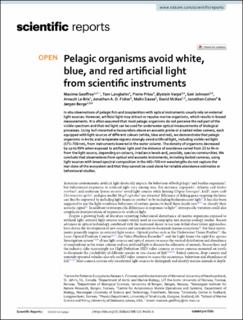| dc.contributor.author | Geoffroy, Maxime | |
| dc.contributor.author | Langbehn, Tom | |
| dc.contributor.author | Priou, Pierre | |
| dc.contributor.author | Varpe, Øystein | |
| dc.contributor.author | Johnsen, Geir | |
| dc.contributor.author | Le Bris, Arnault | |
| dc.contributor.author | Fisher, Jonathan A. D. | |
| dc.contributor.author | Daase, Malin | |
| dc.contributor.author | Mckee, David | |
| dc.contributor.author | Cohen, Jonathan H. | |
| dc.contributor.author | Berge, Jørgen | |
| dc.date.accessioned | 2021-08-17T13:28:57Z | |
| dc.date.available | 2021-08-17T13:28:57Z | |
| dc.date.created | 2021-08-11T11:37:41Z | |
| dc.date.issued | 2021 | |
| dc.identifier.issn | 2045-2322 | |
| dc.identifier.uri | https://hdl.handle.net/11250/2768937 | |
| dc.description.abstract | In situ observations of pelagic fish and zooplankton with optical instruments usually rely on external light sources. However, artificial light may attract or repulse marine organisms, which results in biased measurements. It is often assumed that most pelagic organisms do not perceive the red part of the visible spectrum and that red light can be used for underwater optical measurements of biological processes. Using hull-mounted echosounders above an acoustic probe or a baited video camera, each equipped with light sources of different colours (white, blue and red), we demonstrate that pelagic organisms in Arctic and temperate regions strongly avoid artificial light, including visible red light (575–700 nm), from instruments lowered in the water column. The density of organisms decreased by up to 99% when exposed to artificial light and the distance of avoidance varied from 23 to 94 m from the light source, depending on colours, irradiance levels and, possibly, species communities. We conclude that observations from optical and acoustic instruments, including baited cameras, using light sources with broad spectral composition in the 400–700 nm wavelengths do not capture the real state of the ecosystem and that they cannot be used alone for reliable abundance estimates or behavioural studies. | en_US |
| dc.language.iso | eng | en_US |
| dc.publisher | Nature | en_US |
| dc.rights | Navngivelse 4.0 Internasjonal | * |
| dc.rights.uri | http://creativecommons.org/licenses/by/4.0/deed.no | * |
| dc.title | Pelagic organisms avoid white, blue, and red artificial light from scientific instruments | en_US |
| dc.type | Journal article | en_US |
| dc.type | Peer reviewed | en_US |
| dc.description.version | publishedVersion | en_US |
| dc.rights.holder | Copyright 2021 The Authors | en_US |
| dc.source.articlenumber | 14941 | en_US |
| cristin.ispublished | true | |
| cristin.fulltext | original | |
| cristin.qualitycode | 1 | |
| dc.identifier.doi | 10.1038/s41598-021-94355-6 | |
| dc.identifier.cristin | 1925285 | |
| dc.source.journal | Scientific Reports | en_US |
| dc.identifier.citation | Scientific Reports. 2021, 11 (1), 14941. | en_US |
| dc.source.volume | 11 | en_US |
| dc.source.issue | 1 | en_US |

